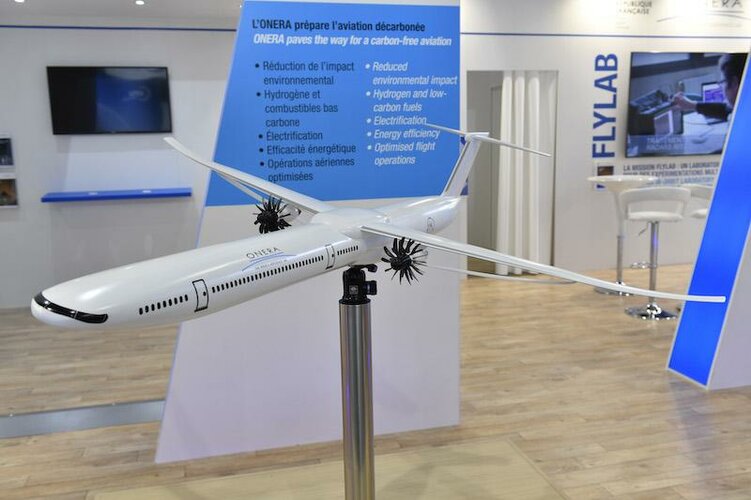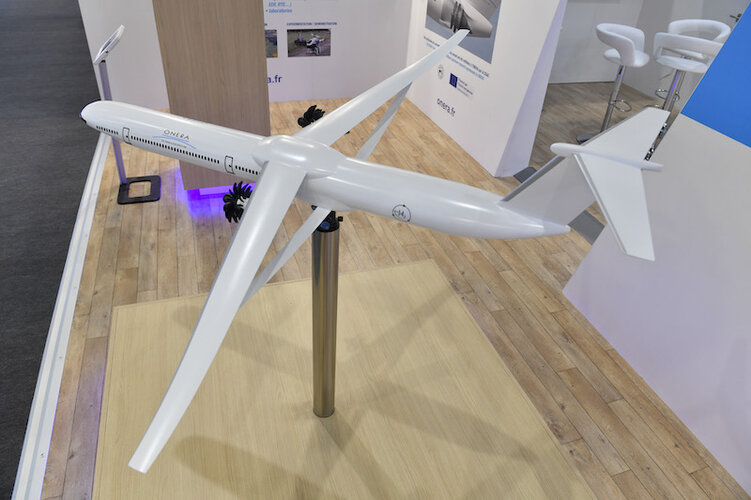You are using an out of date browser. It may not display this or other websites correctly.
You should upgrade or use an alternative browser.
You should upgrade or use an alternative browser.
Boeing Truss-Braced Wing concepts & X-66
- Thread starter Triton
- Start date
That’s the point as the 737 is maxed out in that respect.The nacelles look to have some growth potential mounted that high up.
Scott Kenny
ACCESS: USAP
- Joined
- 15 May 2023
- Messages
- 11,628
- Reaction score
- 14,305
Another trick will be convincing passengers and airline executives that UHB/Open-Fan engines are new and sophisticated, not a rehash of old noisy props.
Though I did see a Piper PA31 fitted with an 11-bladed prop on one engine that greatly changed the noise on takeoff. Sounded much more jetlike. Higher pitched and more like a continuous whistle. Higher pitch means it doesn't carry as far. https://www.mt-propeller.com/en/entw/about_firsts.htm#11 As for why 11 blades? That's a prime number, so there's only one resonant frequency to deal with.
So maybe the high blade count on the Open-Fan will not be as horribly loud.
Though I did see a Piper PA31 fitted with an 11-bladed prop on one engine that greatly changed the noise on takeoff. Sounded much more jetlike. Higher pitched and more like a continuous whistle. Higher pitch means it doesn't carry as far. https://www.mt-propeller.com/en/entw/about_firsts.htm#11 As for why 11 blades? That's a prime number, so there's only one resonant frequency to deal with.
So maybe the high blade count on the Open-Fan will not be as horribly loud.
How often has the wing truss collapsed the fuselage in C-130, C-141, C-5, or C-17 crashes?there is not much of a load bearing structure on the upper part of the fuselage here.
True. It's possible that they will simply "cheat" and build an internal frame to carry the loads down from the top of the fuselage to the existing load structures in the lower fuselage. After all, this experimental aircraft doesn't need to have a clear cabin for passengers anymore.
A commercial version would need a different load structure entirely. And that is one item I've seen mentioned as an issue -- you end up with a rather strong and relatively heavy structure sitting at the top of the fuselage, ready to come down into the cabin in a crash.
- Joined
- 26 May 2006
- Messages
- 34,894
- Reaction score
- 15,758
About the Boeing Model-765 and NASA N+4 program;
http://ntrs.nasa.gov/archive/nasa/casi.ntrs.nasa.gov/20120009038_2012008934.pdf
How to get this report again ?.
1635yankee
Recovering aeronautical engineer
- Joined
- 18 August 2020
- Messages
- 554
- Reaction score
- 766
If one were to look, one could find a lot of information about noise produced by the "open fan" concept (possibly by searching "propfan acoustics" at ntrs.nasa.gov; the the erstwhile Hamilton Standard Division of UTC did a lot of pioneering work on the concept).Another trick will be convincing passengers and airline executives that UHB/Open-Fan engines are new and sophisticated, not a rehash of old noisy props.
Though I did see a Piper PA31 fitted with an 11-bladed prop on one engine that greatly changed the noise on takeoff. Sounded much more jetlike. Higher pitched and more like a continuous whistle. Higher pitch means it doesn't carry as far. https://www.mt-propeller.com/en/entw/about_firsts.htm#11 As for why 11 blades? That's a prime number, so there's only one resonant frequency to deal with.
So maybe the high blade count on the Open-Fan will not be as horribly loud.
How often has the wing truss collapsed the fuselage in C-130, C-141, C-5, or C-17 crashes?there is not much of a load bearing structure on the upper part of the fuselage here.
True. It's possible that they will simply "cheat" and build an internal frame to carry the loads down from the top of the fuselage to the existing load structures in the lower fuselage. After all, this experimental aircraft doesn't need to have a clear cabin for passengers anymore.
A commercial version would need a different load structure entirely. And that is one item I've seen mentioned as an issue -- you end up with a rather strong and relatively heavy structure sitting at the top of the fuselage, ready to come down into the cabin in a crash.
As for high-wings crushing passenger compartments, it's a straightforward structural issue that affects just about all commuter aircraft and military transports and there is a very similar issue with helicopters, with the engines, transmission, and main rotor right over the main cabin.
- Joined
- 16 April 2008
- Messages
- 9,605
- Reaction score
- 14,493
I didn't mean to suggest it's a real show-stopper, or even a major problem, just that the high wing required rethinking the structures compared to existing airliners. I think it came up in the context of comparisons between various iterations of SUGAR -- Refined SUGAR was a low-wing design and SUGAR High was the truss-braced high-wing equivalent, so the wing structure was one of the points of comparison between the two.
1635yankee
Recovering aeronautical engineer
- Joined
- 18 August 2020
- Messages
- 554
- Reaction score
- 766
G
- Joined
- 4 July 2010
- Messages
- 2,514
- Reaction score
- 3,091
Pratt's Geared Turbofan selected to power X-66A and that has the company salivating about breaking back into the Boeing narrowbody market.
 aviationweek.com
aviationweek.com
Pratt's Boeing TTBW Win Could Open Future Single-Aisle Competition | Aviation Week Network
The PW1100G geared turbofan will power Boeing's high-wing X-66 later this decade, the first Pratt & Whitney engine to power a Boeing narrowbody since the 757.
- Joined
- 3 June 2011
- Messages
- 18,335
- Reaction score
- 12,233
If one were to look, one could find a lot of information about noise produced by the "open fan" concept (possibly by searching "propfan acoustics" at ntrs.nasa.gov; the the erstwhile Hamilton Standard Division of UTC did a lot of pioneering work on the concept).Another trick will be convincing passengers and airline executives that UHB/Open-Fan engines are new and sophisticated, not a rehash of old noisy props.
Though I did see a Piper PA31 fitted with an 11-bladed prop on one engine that greatly changed the noise on takeoff. Sounded much more jetlike. Higher pitched and more like a continuous whistle. Higher pitch means it doesn't carry as far. https://www.mt-propeller.com/en/entw/about_firsts.htm#11 As for why 11 blades? That's a prime number, so there's only one resonant frequency to deal with.
So maybe the high blade count on the Open-Fan will not be as horribly loud.
How often has the wing truss collapsed the fuselage in C-130, C-141, C-5, or C-17 crashes?there is not much of a load bearing structure on the upper part of the fuselage here.
True. It's possible that they will simply "cheat" and build an internal frame to carry the loads down from the top of the fuselage to the existing load structures in the lower fuselage. After all, this experimental aircraft doesn't need to have a clear cabin for passengers anymore.
A commercial version would need a different load structure entirely. And that is one item I've seen mentioned as an issue -- you end up with a rather strong and relatively heavy structure sitting at the top of the fuselage, ready to come down into the cabin in a crash.
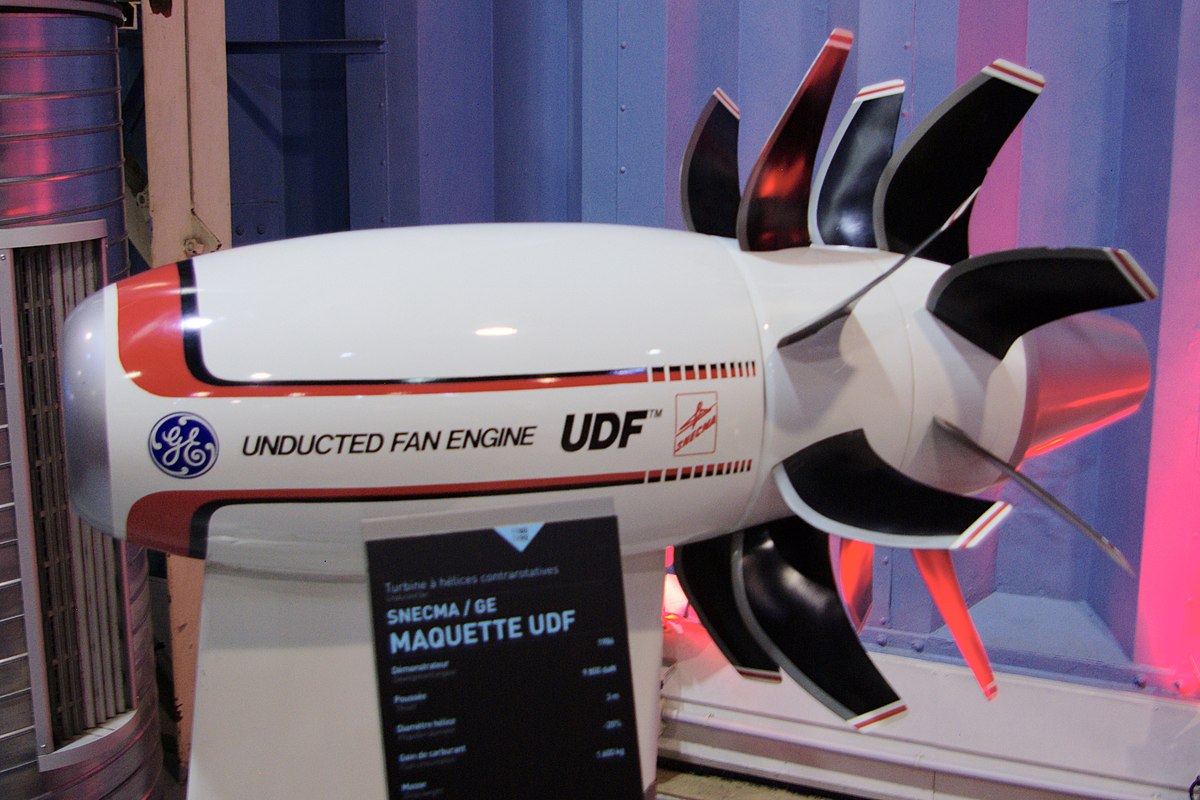
Propfan - Wikipedia
Scott Kenny
ACCESS: USAP
- Joined
- 15 May 2023
- Messages
- 11,628
- Reaction score
- 14,305
Wiki entry notes that the UDFs were louder than the turbofans in the cabin.If one were to look, one could find a lot of information about noise produced by the "open fan" concept (possibly by searching "propfan acoustics" at ntrs.nasa.gov; the the erstwhile Hamilton Standard Division of UTC did a lot of pioneering work on the concept).
As a trained aircraft mechanic, I have a preference for the GE36 type direct drive UDF with many turbine stages. Gear reduction is always a failure point.
Another fun point is flying one of those in icing conditions. Propellers and propfans/UDFs will shed ice load radially into the airframe, which sounds like the plane is getting hit by AA fire. And also requires cabin reinforcement across the line of the blades.
Which means you design for it. Any plane natively designed with a high wing will be designed around that concern.As for high-wings crushing passenger compartments, it's a straightforward structural issue that affects just about all commuter aircraft and military transports and there is a very similar issue with helicopters, with the engines, transmission, and main rotor right over the main cabin.
The only plane this will potentially be an issue on is the converted low wing tech demonstrator.
martinbayer
ACCESS: Top Secret
- Joined
- 6 January 2009
- Messages
- 3,397
- Reaction score
- 3,904
I, for one, am for letting the engineering, environmental, and business processes play out. Good design, bad design - let reality and physics decide.
Last edited:
martinbayer
ACCESS: Top Secret
- Joined
- 6 January 2009
- Messages
- 3,397
- Reaction score
- 3,904
Aaand I just realized that this comment unfortunately applies to the ongoing Titan(ic) drama as well...I, for one, am for letting the engineering, environmental, and business processes play out. Good design, bad design - let reality and physics decide.
- Joined
- 4 July 2010
- Messages
- 2,514
- Reaction score
- 3,091
AirCurrent has a paywalled article discussing CFM Rise on X-66A. The first few paragraphs are readable without a subscription
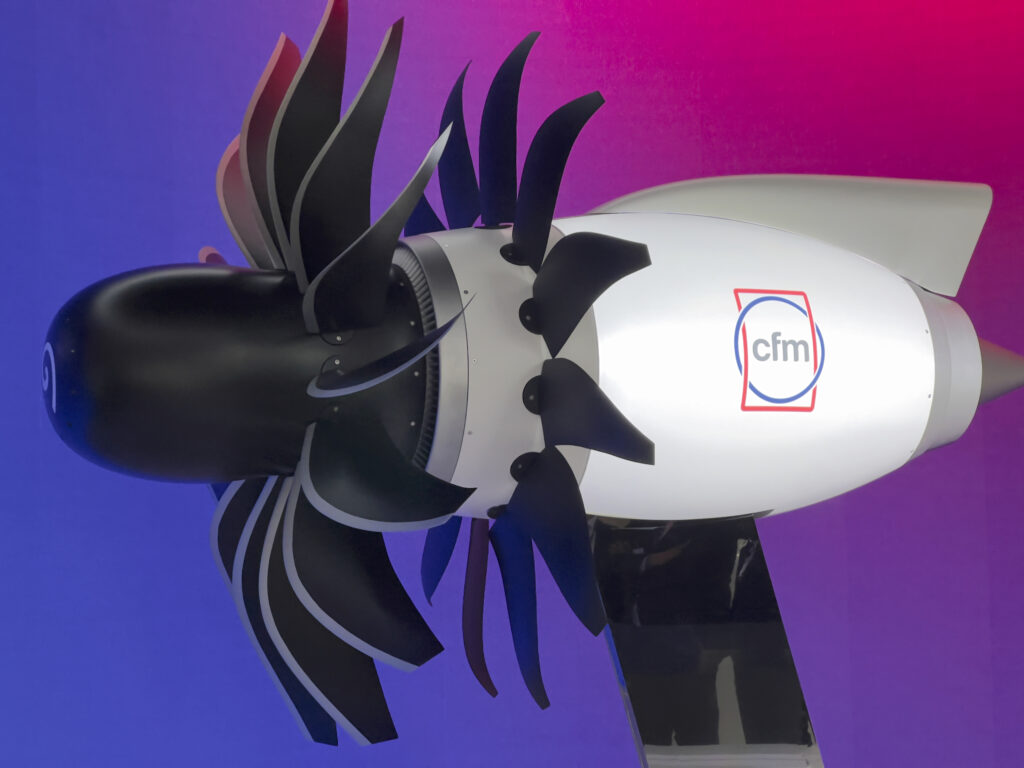
 theaircurrent.com
theaircurrent.com

Boeing will fly CFM’s open fan on Sustainable Flight Demonstrator
After initial testing, Boeing will test CFM’s advanced open fan architecture with a radical configuration of its own. The company sees a long life for X-66A, the NASA lower-emissions test aircraft.
 theaircurrent.com
theaircurrent.com
Scott Kenny
ACCESS: USAP
- Joined
- 15 May 2023
- Messages
- 11,628
- Reaction score
- 14,305
I'm having trouble figuring out if the CFM Rise is a geared engine or not. It sounds like it is, but the white paper is singularly non-useful:AirCurrent has a paywalled article discussing CFM Rise on X-66A. The first few paragraphs are readable without a subscription

Boeing will fly CFM’s open fan on Sustainable Flight Demonstrator
After initial testing, Boeing will test CFM’s advanced open fan architecture with a radical configuration of its own. The company sees a long life for X-66A, the NASA lower-emissions test aircraft.theaircurrent.com
from: https://www.cfmaeroengines.com/wp-content/uploads/2021/07/CFM_RISE_Whitepaper_Media.pdfkey technologies like
multi-variable power control, a pitch actuation
system advanced power gearbox integration.
Notice the lack of comma between "a pitch actuation system" and "advanced power gearbox integration."
Sounds like it is geared, and their admin weenie forgot a comma.
I'm not very fond of adding gears to a turbine engine, that introduces an extra failure point. The GE36 and the Safran CROR are much better from my point of view as a licensed Airframe and Powerplant Mechanic.
taildragger
You can count on me - I won a contest
- Joined
- 2 November 2008
- Messages
- 404
- Reaction score
- 502
Please avoid using "737" and "maxed out" in the same sentence.That’s the point as the 737 is maxed out in that respect.The nacelles look to have some growth potential mounted that high up.
Rhinocrates
ACCESS: Top Secret
- Joined
- 26 September 2006
- Messages
- 3,053
- Reaction score
- 7,780
Not Boeing, but ONERA.
 aviationweek.com
aviationweek.com
Onera Studies Hydrogen-Powered Truss-Braced-Wing Airliner | Aviation Week Network
Onera's Gullhyver concept for a 200-seat, 4,000-nm-range airliner is being studied under Europe’s Clean Aviation public-private research program.
Attachments
Scott Kenny
ACCESS: USAP
- Joined
- 15 May 2023
- Messages
- 11,628
- Reaction score
- 14,305
*facepalm*Not Boeing, but ONERA.
Onera Studies Hydrogen-Powered Truss-Braced-Wing Airliner | Aviation Week Network
Onera's Gullhyver concept for a 200-seat, 4,000-nm-range airliner is being studied under Europe’s Clean Aviation public-private research program.aviationweek.com
Hydrogen SUCKS as an aircraft fuel. It's just not dense enough! Liquid hydrogen is 14 liters per KG, and then you're also dealing with stuff that is extremely low cryotemps.
1635yankee
Recovering aeronautical engineer
- Joined
- 18 August 2020
- Messages
- 554
- Reaction score
- 766
But it's great as a turbine engine fuel and its LHV/kg is a couple of times greater than hydrocarbon fuels*facepalm*Not Boeing, but ONERA.
Onera Studies Hydrogen-Powered Truss-Braced-Wing Airliner | Aviation Week Network
Onera's Gullhyver concept for a 200-seat, 4,000-nm-range airliner is being studied under Europe’s Clean Aviation public-private research program.aviationweek.com
Hydrogen SUCKS as an aircraft fuel. It's just not dense enough! Liquid hydrogen is 14 liters per KG, and then you're also dealing with stuff that is extremely low cryotemps.
Scott Kenny
ACCESS: USAP
- Joined
- 15 May 2023
- Messages
- 11,628
- Reaction score
- 14,305
Sure, for a fixed turbine, like ship propulsion or a gas turbine electrical generator for the grid.But it's great as a turbine engine fuel and its LHV/kg is a couple of times greater than hydrocarbon fuels*facepalm*Not Boeing, but ONERA.
Onera Studies Hydrogen-Powered Truss-Braced-Wing Airliner | Aviation Week Network
Onera's Gullhyver concept for a 200-seat, 4,000-nm-range airliner is being studied under Europe’s Clean Aviation public-private research program.aviationweek.com
Hydrogen SUCKS as an aircraft fuel. It's just not dense enough! Liquid hydrogen is 14 liters per KG, and then you're also dealing with stuff that is extremely low cryotemps.
But Hydrogen forces an immense aircraft with low seating capacity.

First Boeing X-66A donor MD-90 heads to Palmdale
The first of two former Delta Air Lines McDonnell Douglas MD-90-30 aircraft left storage in Victorville, California early July 21 on a short flight to nearby Palmdale where the aircraft will be sliced and diced to become Boeing's Transonic Truss-Braced Wing configured X-66A.
 theaircurrent.com
theaircurrent.com
@admins : should we rename this thread to include the X-66 designation?
1635yankee
Recovering aeronautical engineer
- Joined
- 18 August 2020
- Messages
- 554
- Reaction score
- 766
Let's stick some numbers here. Hydrogen has about 40% greater HHV than kerosene, but its density is about 70kg/m^3 vs about 850 for kerosene, so you'd need about 7 m^3 of liquid hydrogen to replace one of kerosene.Sure, for a fixed turbine, like ship propulsion or a gas turbine electrical generator for the grid.
But Hydrogen forces an immense aircraft with low seating capacity.
Scott Kenny
ACCESS: USAP
- Joined
- 15 May 2023
- Messages
- 11,628
- Reaction score
- 14,305
And that's just tank capacity, not counting all the insulation you will need to keep a -255degC liquid, well, liquid.Let's stick some numbers here. Hydrogen has about 40% greater HHV than kerosene, but its density is about 70kg/m^3 vs about 850 for kerosene, so you'd need about 7 m^3 of liquid hydrogen to replace one of kerosene.
IIRC you are looking at something more than 10m^3 in total tankage volume to replace 1m^3 of jet A. Which is why I do not see hydrogen working for aircraft fuel. Prototypes that show an engine can run on hydrogen? sure. But how much of their passenger or baggage area was filled up with the hydrogen tanks?
Prophet141
ACCESS: Confidential
- Joined
- 25 April 2022
- Messages
- 142
- Reaction score
- 121
I have a question regarding this 11 bladed propeller (and other high blade number propellers). I did a quick search and found an article that suggested it would improve not just power but efficiency. I was under the impression that it was a trade off where the larger number of blades increased power for a given blade length and fan velocity (so you can avoid supersonic blade tips), but that it also results in high disk-loading/interference between blades. Why is it that these propellers can have both increased efficiency and power?Another trick will be convincing passengers and airline executives that UHB/Open-Fan engines are new and sophisticated, not a rehash of old noisy props.
Though I did see a Piper PA31 fitted with an 11-bladed prop on one engine that greatly changed the noise on takeoff. Sounded much more jetlike. Higher pitched and more like a continuous whistle. Higher pitch means it doesn't carry as far. https://www.mt-propeller.com/en/entw/about_firsts.htm#11 As for why 11 blades? That's a prime number, so there's only one resonant frequency to deal with.
So maybe the high blade count on the Open-Fan will not be as horribly loud.
How often has the wing truss collapsed the fuselage in C-130, C-141, C-5, or C-17 crashes?
Also, I understand that even if a 2 blade propeller is more efficient than a higher number of propeller blades, a plane with a 10,000+ hp turboprop/UDF would need a comically large 2 bladed propeller to reach its full potential.
- Joined
- 1 April 2006
- Messages
- 11,390
- Reaction score
- 10,274
I have a question regarding this 11 bladed propeller (and other high blade number propellers).
Scott Kenny
ACCESS: USAP
- Joined
- 15 May 2023
- Messages
- 11,628
- Reaction score
- 14,305
Higher blade counts mean each blade can be narrower, which has a better lift/drag ratio. More lift means more thrust from the prop in that specific case.I have a question regarding this 11 bladed propeller (and other high blade number propellers). I did a quick search and found an article that suggested it would improve not just power but efficiency. I was under the impression that it was a trade off where the larger number of blades increased power for a given blade length and fan velocity (so you can avoid supersonic blade tips), but that it also results in high disk-loading/interference between blades. Why is it that these propellers can have both increased efficiency and power?
Also, I understand that even if a 2 blade propeller is more efficient than a higher number of propeller blades, a plane with a 10,000+ hp turboprop/UDF would need a comically large 2 bladed propeller to reach its full potential.
Higher blade counts can also be smaller diameter, which lets you either spin the prop faster at the design stage, or results in lower propeller tip speed at the engine's max rpm as a retrofit.
Helicoprion
Aircraft enthusiast and Aerospace Machinist
- Joined
- 23 July 2023
- Messages
- 27
- Reaction score
- 57
An even better look at the MD-90 donor fuselage.

 www.nasa.gov
www.nasa.gov

NASA, Boeing, Provide a Peek at What the X-66A Will Look Like
NASA and Boeing have unveiled a new livery for the X-66A aircraft that will be produced through the agency’s Sustainable Flight Demonstrator.
aonestudio
I really should change my personal text
- Joined
- 11 March 2018
- Messages
- 2,964
- Reaction score
- 7,493
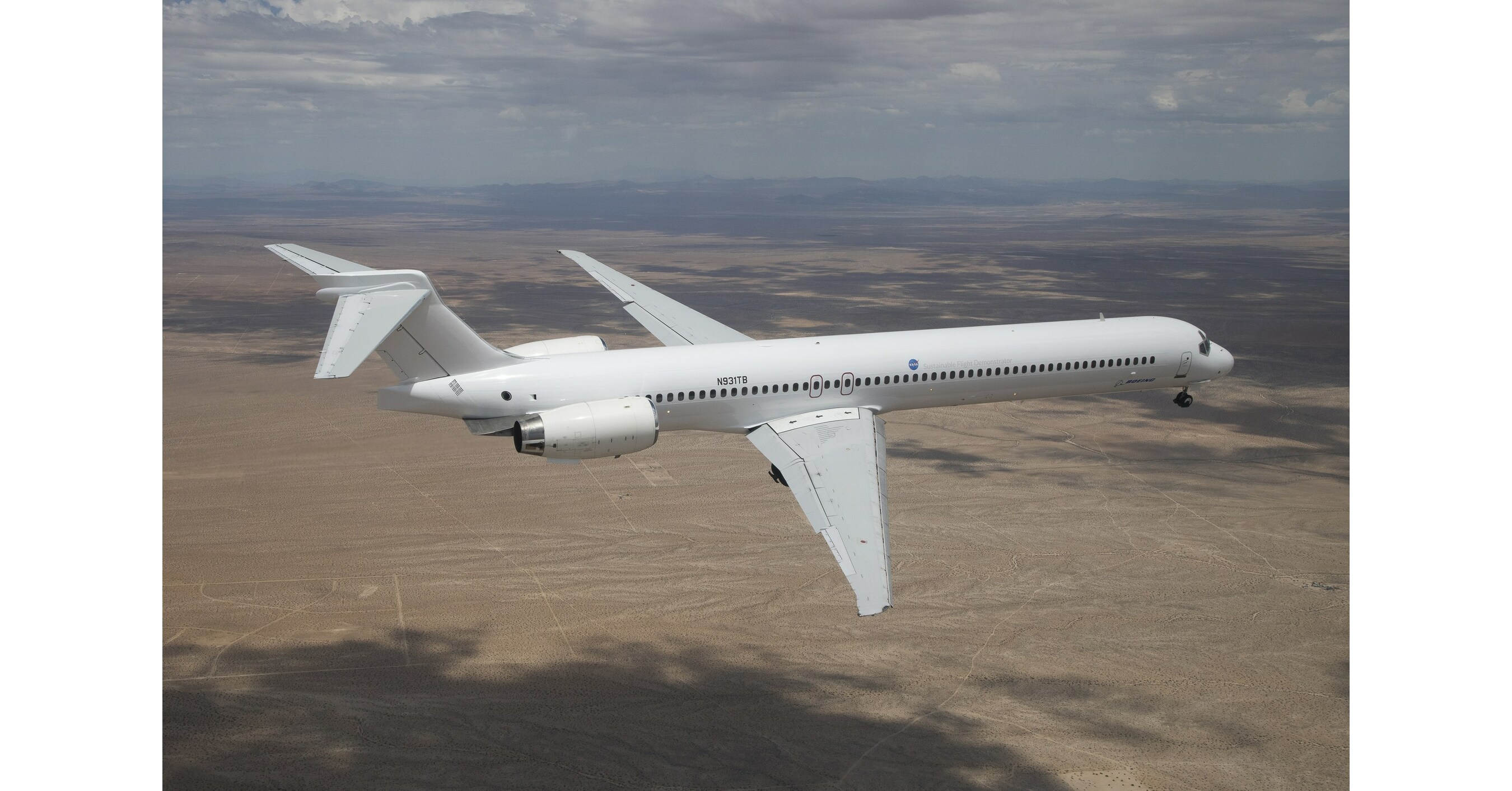
Airplane Arrives at Boeing Site for X-66A Modification
Boeing [NYSE:BA] has ferried an MD-90 airplane to the site where it will be modified to test the Transonic Truss-Braced Wing (TTBW) configuration as part of NASA's Sustainable Flight Demonstrator...
aonestudio
I really should change my personal text
- Joined
- 11 March 2018
- Messages
- 2,964
- Reaction score
- 7,493
- Joined
- 4 July 2010
- Messages
- 2,514
- Reaction score
- 3,091
Paywalled article, Boeing has begun deconstructing the aircraft which will be rebuilt as X-66A
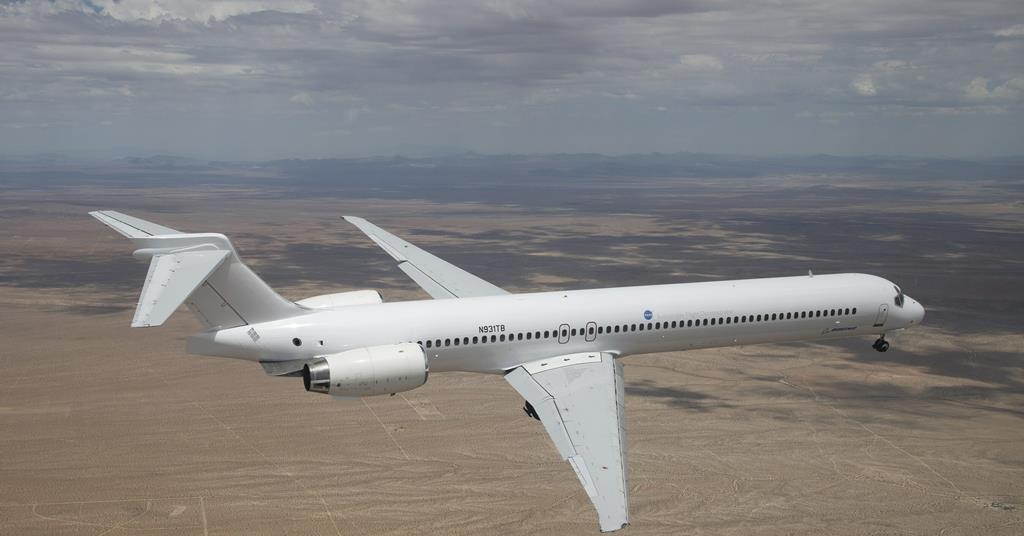
 www.flightglobal.com
www.flightglobal.com

Boeing begins transforming MD-90 into NASA’s X-66A demonstrator
Boeing has started dismantling and scanning an old MD-90 as part of a multi-year NASA-supported project to transform the former passenger jet into the X-66A truss-braced-wing demonstrator.
- Joined
- 1 April 2006
- Messages
- 11,390
- Reaction score
- 10,274
Helicoprion
Aircraft enthusiast and Aerospace Machinist
- Joined
- 23 July 2023
- Messages
- 27
- Reaction score
- 57
3D STL of the X-66a


- Joined
- 9 October 2009
- Messages
- 21,969
- Reaction score
- 13,616

Boeing updates X-66A progress as details of PW102XG engines emerge
Boeing has disclosed fresh details on the progress of the X-66A truss-braced-wing demonstrator it is developing under a NASA-backed project, including confirmation that the aircraft will be powered by a derivative of the Pratt & Whitney PW1500G engine designated the PW102XG.
Scott Kenny
ACCESS: USAP
- Joined
- 15 May 2023
- Messages
- 11,628
- Reaction score
- 14,305
It's really going to take some good sales pitch for any open rotor or unducted fan engines...
Boeing updates X-66A progress as details of PW102XG engines emerge
Boeing has disclosed fresh details on the progress of the X-66A truss-braced-wing demonstrator it is developing under a NASA-backed project, including confirmation that the aircraft will be powered by a derivative of the Pratt & Whitney PW1500G engine designated the PW102XG.www.flightglobal.com
1635yankee
Recovering aeronautical engineer
- Joined
- 18 August 2020
- Messages
- 554
- Reaction score
- 766
It probably would, which may be why there are no plans to do so.It's really going to take some good sales pitch for any open rotor or unducted fan engines...
taildragger
You can count on me - I won a contest
- Joined
- 2 November 2008
- Messages
- 404
- Reaction score
- 502
Boeing has pointed out that the X-66 configuration is well suited to an engine with blades so probably sees re-engining down the road as a possibility. The purpose of the airplane is aerodynamic and structural research though so throwing a another innovation into that mix in the early stages would probably be unwise.It probably would, which may be why there are no plans to do so.
Last edited:
Similar threads
-
-
NEWS: Clean engines, wings that fold: Boeing dreams of futuristic jets
- Started by Sentinel Chicken
- Replies: 2
-
-
Planes of the Future: Boeing's 1950 jet-transport designs
- Started by overscan (PaulMM)
- Replies: 1
-

